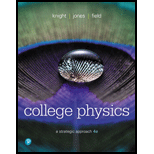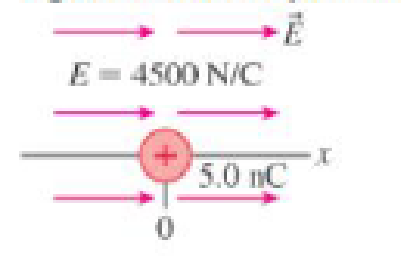
College Physics: A Strategic Approach Plus Mastering Physics with Pearson eText -- Access Card Package (4th Edition) (What's New in Astronomy & Physics)
4th Edition
ISBN: 9780134641492
Author: Randall D. Knight (Professor Emeritus), Brian Jones, Stuart Field
Publisher: PEARSON
expand_more
expand_more
format_list_bulleted
Concept explainers
Textbook Question
Chapter 20, Problem 60GP
As shown in Figure P20.52, a 5.0 nC charge sits at x = 0 in a uniform 4500 N/C electric field directed to the right. At what point along the x-axis would (a) a proton and (b) an electron experience no net force?
Figure P20.52

Expert Solution & Answer
Want to see the full answer?
Check out a sample textbook solution
Students have asked these similar questions
3.63 • Leaping the River II. A physics professor did daredevil
stunts in his spare time. His last stunt was an attempt to jump across
a river on a motorcycle (Fig. P3.63). The takeoff ramp was inclined at
53.0°, the river was 40.0 m wide, and the far bank was 15.0 m lower
than the top of the ramp. The river itself was 100 m below the ramp.
Ignore air resistance. (a) What should his speed have been at the top of
the ramp to have just made it to the edge of the far bank? (b) If his speed
was only half the value found in part (a), where did he land?
Figure P3.63
53.0°
100 m
40.0 m→
15.0 m
Please solve and answer the question correctly please. Thank you!!
You throw a small rock straight up from the edge of a highway bridge that crosses a river. The rock passes you on its way down, 5.00 s after it was thrown. What is the speed of the rock just before it reaches the water 25.0 m below the point where the rock left your hand? Ignore air resistance.
Chapter 20 Solutions
College Physics: A Strategic Approach Plus Mastering Physics with Pearson eText -- Access Card Package (4th Edition) (What's New in Astronomy & Physics)
Ch. 20 - Four lightweight balls A, B, C, and D are...Ch. 20 - Plastic and glass rods that have been charged by...Ch. 20 - When you take clothes out of the drier right after...Ch. 20 - The positive charge in Figure Q20.5 is +Q. What is...Ch. 20 - As shown in Figure Q20.6, metal sphere A has 4...Ch. 20 - Figure Q20.7 shows a positively charged rod held...Ch. 20 - A plastic balloon that has been rubbed with wool...Ch. 20 - You are given two metal spheres on portable...Ch. 20 - A metal rod A and a metal sphere B, on insulating...Ch. 20 - Prob. 10CQ
Ch. 20 - Prob. 11CQCh. 20 - Prob. 12CQCh. 20 - Prob. 13CQCh. 20 - Prob. 14CQCh. 20 - Prob. 15CQCh. 20 - Prob. 16CQCh. 20 - Iontophoresis is a noninvasive process that...Ch. 20 - A positively charged particle is in the center of...Ch. 20 - Two charged particles are separated by 10 cm....Ch. 20 - A small positive charge q experiences a force of...Ch. 20 - A typical commercial airplane is struck by...Ch. 20 - Microbes such as bacteria have small positive...Ch. 20 - a. Is there a point between a 10 nC charge and a...Ch. 20 - Prob. 24CQCh. 20 - Prob. 25CQCh. 20 - Prob. 26MCQCh. 20 - Prob. 27MCQCh. 20 - Prob. 28MCQCh. 20 - Prob. 29MCQCh. 20 - A glass bead charged to +3.5 nC exerts an 8.0 104...Ch. 20 - A +7.5 nC point charge and a 2.0 nC point charge...Ch. 20 - Prob. 32MCQCh. 20 - Prob. 33MCQCh. 20 - Prob. 34MCQCh. 20 - Prob. 35MCQCh. 20 - Prob. 36MCQCh. 20 - Prob. 37MCQCh. 20 - A glass rod is charged to +5.0 nC by rubbing. a....Ch. 20 - Prob. 2PCh. 20 - A plastic rod is charged to 20 nC by rubbing. a....Ch. 20 - Prob. 4PCh. 20 - A plastic rod that has been charged to 15.0 nC...Ch. 20 - A glass rod that has been charged to +12.0 nC...Ch. 20 - Two identical metal spheres A and Bare in contact....Ch. 20 - Two identical metal spheres A and Bare connected...Ch. 20 - Prob. 9PCh. 20 - Prob. 10PCh. 20 - Two 1.0 kg masses are 1.0 m apart on a...Ch. 20 - Prob. 12PCh. 20 - Prob. 13PCh. 20 - A small plastic sphere with a charge of 5.0 nC is...Ch. 20 - A small metal bead, labeled A, has a charge of 25...Ch. 20 - A small glass bead has been charged to +20 nC. A...Ch. 20 - Prob. 17PCh. 20 - Prob. 18PCh. 20 - Object A, which has been charged to +10 nC, is at...Ch. 20 - Prob. 20PCh. 20 - What magnitude charge creates a 1.0 N/C electric...Ch. 20 - Prob. 22PCh. 20 - What are the strength and direction of the...Ch. 20 - Prob. 24PCh. 20 - What are the strength and direction of the...Ch. 20 - A 30 nC charge experiences a 0.035 N electric...Ch. 20 - A 10 nC charge is located at the origin. a. What...Ch. 20 - A +1 0 nC charge is located at the origin. a. What...Ch. 20 - Prob. 29PCh. 20 - Prob. 30PCh. 20 - A parallel-plate capacitor is constructed of two...Ch. 20 - Prob. 32PCh. 20 - A parallel-plate capacitor is formed from two 4.0...Ch. 20 - Two identical closely spaced circular disks form a...Ch. 20 - A parallel-plate capacitor is constructed of two...Ch. 20 - Prob. 36PCh. 20 - Prob. 37PCh. 20 - Prob. 38PCh. 20 - What are the strength and direction of an electric...Ch. 20 - Prob. 40PCh. 20 - A 0.10 g plastic bead is charged by the addition...Ch. 20 - Prob. 42PCh. 20 - One kind of e-book display consists of millions of...Ch. 20 - Prob. 44PCh. 20 - A protein molecule in an electrophoresis gel has a...Ch. 20 - Large electric fields in cell membranes cause ions...Ch. 20 - Molecules of carbon mon-oxide are permanent...Ch. 20 - A 2.0-mmdiameter copper ball is charged to +50 nC....Ch. 20 - Two protons are 2.0 fm apart. (1 fm= 1 femtometer...Ch. 20 - The nucleus of a 12Xe atom (an isotope of the...Ch. 20 - Two equally charged, 1.00 g spheres are placed...Ch. 20 - An electric dipole is formed from 1.0 nC point...Ch. 20 - Prob. 53GPCh. 20 - Prob. 54GPCh. 20 - Prob. 55GPCh. 20 - Prob. 56GPCh. 20 - Prob. 57GPCh. 20 - Prob. 58GPCh. 20 - Prob. 59GPCh. 20 - As shown in Figure P20.52, a 5.0 nC charge sits at...Ch. 20 - Prob. 61GPCh. 20 - In a simple model of the hydrogen atom, the...Ch. 20 - A 0.10 g honeybee acquires a charge of +23 pC...Ch. 20 - Two 2.0-cm-diameter disks face each other, 1.0 mm...Ch. 20 - The electron gun in a television tube uses a...Ch. 20 - Prob. 66GPCh. 20 - A 4.0 mg bead with a charge of 2.5 nC rests on a...Ch. 20 - Prob. 68GPCh. 20 - A small charged bead has a mass of 1.0 g. It is...Ch. 20 - A bead with a mass of 0.050 g and a charge of 15...Ch. 20 - Prob. 71GPCh. 20 - Prob. 72GPCh. 20 - A small bead with a positive charge q is free to...Ch. 20 - A parallel-plate capacitor consists of two plates,...Ch. 20 - Which of the following describes the charges on...Ch. 20 - Because the droplets are conductors, a droplet's...Ch. 20 - Another way to sort the droplets would be to give...
Additional Science Textbook Solutions
Find more solutions based on key concepts
In mechanism, photophosphorylation is most similar to A. substrate-level phosphorylation in glycolysis. B. oxid...
Campbell Biology in Focus (2nd Edition)
Match each of the following items with all the terms it applies to:
Human Physiology: An Integrated Approach (8th Edition)
1. Which parts of the skeleton belong to the appendicular skeleton? Which belong to the axial skeleton?
Human Anatomy & Physiology (2nd Edition)
Choose the best answer to each of the following. Explain your reasoning. What is the leading hypothesis for Ven...
Cosmic Perspective Fundamentals
10.71 Identify each of the following as an acid or a base: (10.1)
H2SO4
RbOH
Ca(OH)2
HI
...
Chemistry: An Introduction to General, Organic, and Biological Chemistry (13th Edition)
Based on your answers to Questions 2 and 3, which part of the Atlantic basin appears to have opened first?
Applications and Investigations in Earth Science (9th Edition)
Knowledge Booster
Learn more about
Need a deep-dive on the concept behind this application? Look no further. Learn more about this topic, physics and related others by exploring similar questions and additional content below.Similar questions
- Help me make a visualize experimental setup using a word document. For the theory below.arrow_forwardHow to solve this, given answerarrow_forwardThree point-like charges are placed at the corners of a square as shown in the figure, 28.0 cm on each side. Find the minimum amount of work required by an external force to move the charge q1 to infinity. Let q1=-2.10 μC, q2=+2.40 μС, q3=+3.60 μC.arrow_forward
- A point charge of -4.00 nC is at the origin, and a second point charge of 6.00 nC is on the x axis at x= 0.820 mm . Find the magnitude and direction of the electric field at each of the following points on the x axis. x2 = 19.0 cmarrow_forwardFour point-like charges are placed as shown in the figure, three of them are at the corners and one at the center of a square, 36.0 cm on each side. What is the electric potential at the empty corner? Let q1=q3=+26.0 µС, q2=-28.0 μC, and q4=-48.0μc Varrow_forwardPLS HELparrow_forward
arrow_back_ios
SEE MORE QUESTIONS
arrow_forward_ios
Recommended textbooks for you
 Physics for Scientists and Engineers: Foundations...PhysicsISBN:9781133939146Author:Katz, Debora M.Publisher:Cengage Learning
Physics for Scientists and Engineers: Foundations...PhysicsISBN:9781133939146Author:Katz, Debora M.Publisher:Cengage Learning Physics for Scientists and EngineersPhysicsISBN:9781337553278Author:Raymond A. Serway, John W. JewettPublisher:Cengage Learning
Physics for Scientists and EngineersPhysicsISBN:9781337553278Author:Raymond A. Serway, John W. JewettPublisher:Cengage Learning Physics for Scientists and Engineers with Modern ...PhysicsISBN:9781337553292Author:Raymond A. Serway, John W. JewettPublisher:Cengage Learning
Physics for Scientists and Engineers with Modern ...PhysicsISBN:9781337553292Author:Raymond A. Serway, John W. JewettPublisher:Cengage Learning Principles of Physics: A Calculus-Based TextPhysicsISBN:9781133104261Author:Raymond A. Serway, John W. JewettPublisher:Cengage Learning
Principles of Physics: A Calculus-Based TextPhysicsISBN:9781133104261Author:Raymond A. Serway, John W. JewettPublisher:Cengage Learning College PhysicsPhysicsISBN:9781305952300Author:Raymond A. Serway, Chris VuillePublisher:Cengage Learning
College PhysicsPhysicsISBN:9781305952300Author:Raymond A. Serway, Chris VuillePublisher:Cengage Learning College PhysicsPhysicsISBN:9781285737027Author:Raymond A. Serway, Chris VuillePublisher:Cengage Learning
College PhysicsPhysicsISBN:9781285737027Author:Raymond A. Serway, Chris VuillePublisher:Cengage Learning

Physics for Scientists and Engineers: Foundations...
Physics
ISBN:9781133939146
Author:Katz, Debora M.
Publisher:Cengage Learning

Physics for Scientists and Engineers
Physics
ISBN:9781337553278
Author:Raymond A. Serway, John W. Jewett
Publisher:Cengage Learning

Physics for Scientists and Engineers with Modern ...
Physics
ISBN:9781337553292
Author:Raymond A. Serway, John W. Jewett
Publisher:Cengage Learning

Principles of Physics: A Calculus-Based Text
Physics
ISBN:9781133104261
Author:Raymond A. Serway, John W. Jewett
Publisher:Cengage Learning

College Physics
Physics
ISBN:9781305952300
Author:Raymond A. Serway, Chris Vuille
Publisher:Cengage Learning

College Physics
Physics
ISBN:9781285737027
Author:Raymond A. Serway, Chris Vuille
Publisher:Cengage Learning
Electric Fields: Crash Course Physics #26; Author: CrashCourse;https://www.youtube.com/watch?v=mdulzEfQXDE;License: Standard YouTube License, CC-BY